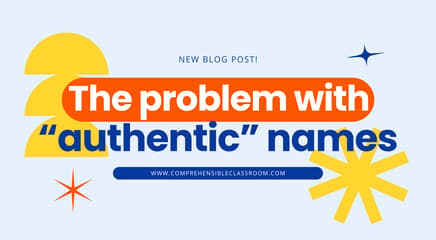The Three Steps of TPRS are the core framework of the TPRS strategy for delivering comprehensible input. They are laid out in the "Green Bible" (Fluency through TPR Storytelling), but like anything--everyone carries them out with their own unique style.
 For those teachers that are either using my story scripts or following The Somos Curriculum, here is an explanation of what the Three Steps of TPRS look like in a typical TPRS story in my classroom:
For those teachers that are either using my story scripts or following The Somos Curriculum, here is an explanation of what the Three Steps of TPRS look like in a typical TPRS story in my classroom:
TPRS STEP 1: ESTABLISH MEANING
When I introduce the target structures for each formal script, I follow a fairly rigid structure--this process is not necessary, and you may choose to establish meaning by simply telling students what the words/word chunks mean in students' first language and moving on to Step Two! First, I write the structure on the board in Spanish with a black marker. Students repeat it. Then, I write the English translation on the board with a blue marker and explain the meaning. We repeat the structure and translation a few times with some call and response, and I add a small sketch of the meaning with a red marker. I also point out any grammatical components of the structure that I want to highlight, and mark them with a green marker. (For example, I would use green to underline these parts of habla - s/he talks so that students would see that the -a ending means s/he.) Finally, we create a gesture for the structure. I repeat the process for each of the (typically) three target structures.
Then, students get individual whiteboards, and I throw the practice sentences up on the board in Spanish. They must be sentences that students can translate, so I am careful to choose only structures and terms that students already know in Spanish. The target structure should be the only new structure in each practice sentence. Since the translations are on the board, students are able to translate them. Students write their translations on their individual whiteboards, and when I give a signal, everyone holds them up at the same time. I put up the correct translation, and we move on to the next sentence. After we finish the practice sentences, I put the questions for individual response on the board and ask students to write their responses on the whiteboard. Depending on how much time is left in the class period, I may save them to use as a Campanada (bell-ringer/warm-up) the next day, or you could even assign them as homework. (Click here to read another post about how I introduce vocab.)
TPRS STEP 2 (A): DISCUSS
Next, we move on to the personalized questions for class discussion. There are exactly what the title describes: questions for the whole class to discuss. Sometimes, I use them in a Campanada so that students have already formulated a response when it comes time to discuss the answers, but other times they hear the question for the first time in the discussion. This part (hopefully) takes a long time because we get a good discussion going!
TPRS STEP 2 (B): ASK THE STORY
 Click on the above image to download a comprehensive explanation of how to ask a story from one of my scripts!
Click on the above image to download a comprehensive explanation of how to ask a story from one of my scripts!
Finally, we begin the story. The story script is meant to be used as a guide to ask the story: it is not meant to be read to or by the students. When I post scripts, the target structures are in bold, and the variables are underlined. Variables are the components of the story that are meant to be “asked” instead of told; the details that are decided by the students. The rest of the story, the plain text, should be told and circled, but it is (somewhat) important to keep it to what I’ve written so that the story follows a line that includes all of the target structures.
TPRS STEP 2 (C): PLAY WITH THE STORY
After the story is asked, you can begin to do all of the follow-up reading and re-telling activities. Read about different ways to play with stories here!
TPRS STEP 3: READ
The final step of TPRS is "Read" (literacy), and it is a two-step process in my classes. I project a short text that contains the target structures (a different/amplified version of the class story or a completely unrelated text--perhaps something cultural), and we read it as a class as I circle target structures, check for comprehension, and personalize the content (click here for tutorials). Once we've done a class reading and I am confident that students have acquired the structures, I give a reading assessment.
STORYASKING IN ACTION: Here is a video of Carol Gaab teaching English to a group of baseball players:
If I were to write a script for this video, it would look something like this: This is Marcos. Marcos wants to play baseball in the big leagues. But Marcos has a problem. He has a bad shoulder, so he can't play baseball.
The target structures would be wants, has, and can't. Carol asked the details that are underlined--the players determined what he wants to do and what is the problem that he has that prohibits him from playing baseball. Each time that she added a new piece of information, she circled it by asking yes/no questions (Does Marcos want to play baseball? Yes), either/or question (Does Marcos want to play baseball or to have a baby?), open-ended questions (What does Marcos want? To play baseball), and for details (Does he want to play baseball in the minor leagues or the big leagues?).
You can also check out this demo of me asking a part of my "Cierra la puerta" story.




